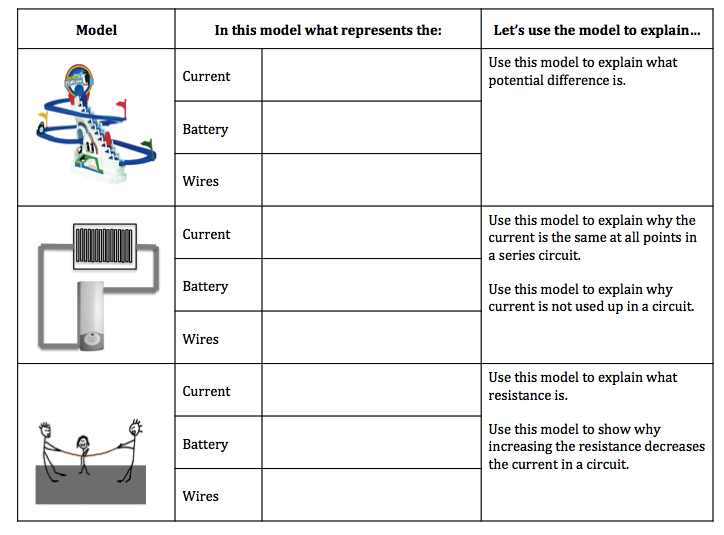Electricity and electric circuits teaching resources
Worksheets and lesson ideas to challenge students aged 11 to 16 to think hard about electric circuits (GCSE and Key Stage 3)
Electricity is a challenging concept to teach. Concepts like potential difference and current are incredibly abstract – these ideas are novel and not easily linked to the concrete world. Secondly, many concepts go against children’s naive ideas e.g. current is used up when it passes through a component. It is important that ideas are introduced with real caution and that the ideas of current, voltage and energy are dealt with separately first (Driver et al., 1994).
Current is the flow of charge. Voltage (or better still potential difference) is needed for current to flow and is best introduced first as a property of an isolated battery; note that a voltage can be present even when no current is flowing. Current transfers energy around the circuit from the battery to various components (resistors). At resistors the electrical energy is transferred into other forms. This analogy model below will help consolidate understanding around the concepts of current, voltage and electrical energy. As with all analogies, there are limitations and it’s best to use more than one.
Where to start?
The light bulb challenge. Ask students to light a bulb using only a wire and a battery. This simple activity often challenges students – many think it is impossible to do with only one wire! It would be an excellent way to introduce the topic on electrical circuits. Click on this link to see how MIT graduates coped with this science challenge.
Static electricity
Key Stage 3 worksheet on static electricity. Students use a series of models to help them explain what happens when you rub a balloon against hair. Thanks to Roz Chalk for advice on how to approach the concept of charge. This activity provides a framework to begin thinking about charge, potential difference and current. (PDF)
The electric sausage is a great demonstration to introduce electric fields and static charges.
This is an excellent blog describing how to use the rope model to explain current and resistance.
Static electricity animation
This fantastic Phet animation provides a great starting point to begin thinking about charge, conductors, current and energy before electrical circuits are introduced.
Voltage, current and resistance: an analogy
Key Stage 3 and GCSE worksheet on current, voltage and resistance. Students use three different concrete models to help understand and describe current, voltage and resistance. By using three analogy models, we are hoping to prevent students from taking any one model too literarily. It could also be a nice opportunity for students to build their own models to explain the essential features of electrical circuits. (PDF)
Series and parallel circuits
This is a fantastic tool to draw circuit diagrams using a computer.
Key Stage 3 worksheet on series and parallel circuits. Students consider whether a series or parallel circuit would be best for their Christmas tree lights. This activity can easily be extended to look at the similarities and differences between the circuits with respect to voltage, current and resistance. (PDF)
Engaging demonstrations
Try the energy stick with your classes. A great way to investigate current, conductors and resistance. Or see how two different kinds of homemade play dough can be used to demonstrate electrical properties — by lighting up LEDs, spinning motors, and turning little kids into circuit designers.

